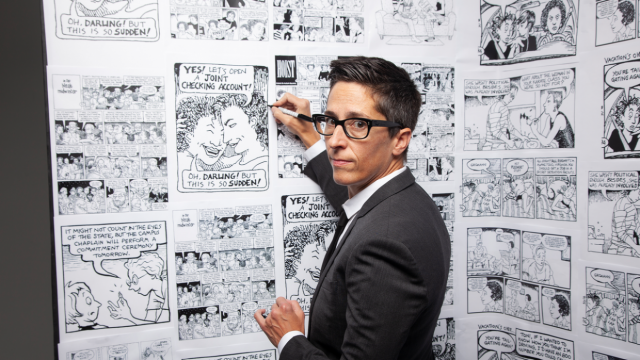The FAR has mastered rendering the pirate on the back of the matchbook and now enjoys drawing all sorts of things: comics, animation, connections between classic films, conclusions about book narrators, and cards.
Thanks to Casper and Drunk Napoleon for shading in some extra areas this week. Send articles throughout the next week to ploughmanplods [at] gmail, post articles from the past week below for discussion, and Have a Happy Friday!
Sally McGee interviews director Vivian Kleiman for Filmmaker Magazine about her new documentary No Straight Lines: The Rise of Queer Comics, the influence of Marlon Riggs, and editing during the pandemic:
Pre-COVID, I was very dedicated to the notion of not including any erotica, [and] keeping it focused on more literary kinds of comics. It was kind of unconscious, but I realized afterward when I was doing the sound mix that I actually had allowed much more explicit content to enter into the film than I would have otherwise. It felt like I became slightly more uncensored, perhaps thinking less about distribution and more thinking about a film that represents the range of queer comics in the broadest sense, [and] that includes some erotica. That was a huge impact of COVID.
A deep dive into Luca and other Disney things by Cameron Scheetz at The AV Club, where he pontificates on whether the film has gay characters or merely gay subtext, and thoughts on the value of looking for these things:
When Pixar isn’t making us reconsider throwing out old toys, or question a rat’s palate, it’s digging deep into our psyches, anthropomorphizing souls and feelings—one can understand why Luca might be seen as less ambitious by comparison. But, in this writer’s estimation, the more intimate, ground-and-sea-level storytelling is what makes Luca Pixar’s most affecting tale in quite a few years. Though the movie doesn’t spend much time fleshing out Luca’s underwater life, his interior world is immediately clear, especially when human “gadgets and gizmos a-plenty” pique his interest for something more. (Shout out to Ariel.) His family cares for him deeply, but there’s something inside calling out for more, and that something becomes personified when he meets Alberto, a bold and adventurous sea monster whose way of thinking literally expands Luca’s world. The “sea monsters = gay” metaphor doesn’t hold up to scrutiny when you consider that Luca’s own parents, clearly gendered male and female, are also sea monsters. But that subtext is there regardless, and those who grew up closeted or questioning their own sexuality will almost certainly relate to aspects of Luca’s journey.
Variety’s Matthew Jacobs looks at the inescapable influence of 1968’s Rosemary’s Baby, including in new release False Positive:
With such towering contemporary esteem, Rosemary’s Baby may be the gold standard of highbrow American horror, even if its director will never step foot in this country again. Its legacy has only proliferated in recent years. The Dakota, the Manhattan building where the Woodhouses lived, became a popular tourist destination after John Lennon was killed there in 1980; 2014 brought a lackluster TV remake starring Zoe Saldana. In an age saturated by commercially safe franchises, Rosemary’s Baby represents the pinnacle of studio filmmaking — a shrewd, peculiar, and seemingly unmarketable excursion into the ghoulish human psyche that became a sensation.
For Slate, Laura Miller talks about the challenges of representation in audiobook narration, where a single book can contain a multitude of characters with different nationalities and ethnicities, and provides a fascinating window into the process of recording an audiobook:
The one motto that nearly every audiobook professional I interviewed repeated to me when I asked about their strategies for dealing with accents is “less is more.” Kevin R. Free—a Black theater actor who began narrating audiobooks 20 years ago and has become the voice of both a soap opera–addicted cyborg in Martha Wells’ Murderbot series and of Eric Carle’s iconic picture books (The Very Hungry Caterpillar, etc.)—laughingly recalled reporting for his very first recording session armed with a set of theatrically bold character voices, only to be told by his director: “I don’t want you to think of doing this book as doing a solo show. … There’s no reason for you to go all the way there.”* That holds especially true for cross-cultural accents. If Ballerini feels that “maybe I’m not the right person to give a voice to this particular character, let me just do it as plainly and as simply as I can. I think that’s a general trend that’s happening in the industry.”
Brad Andres began posting a developer’s diary at BoardGameGeek about adapting the particular and peculiar themes and schemes of Fight Club into an upcoming card game:
You might wonder why I did not just design a regular deck building game? I felt the unique opportunity of having two characters that were actually (spoiler alert) the same person was too exciting to pass up. In a traditional deck-building game each player is represented by a single deck, and in Fight Club: The Home Game, each person is still represented by a single deck. Tyler and “The Narrator” are two halves of a single entity, warring for control. I wanted the players to feel this push and pull, this lack of complete control over their options, and an inability to completely define their deck’s identity like they normally would. Seeing as the main theme of Fight Club is at its heart a search for identity, it felt like a natural fit for the game.

